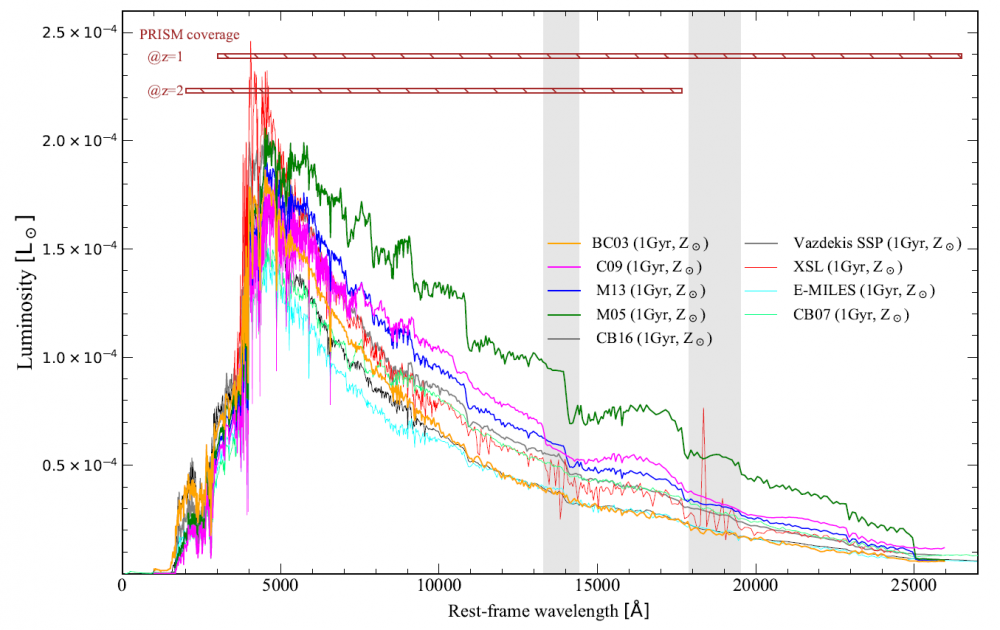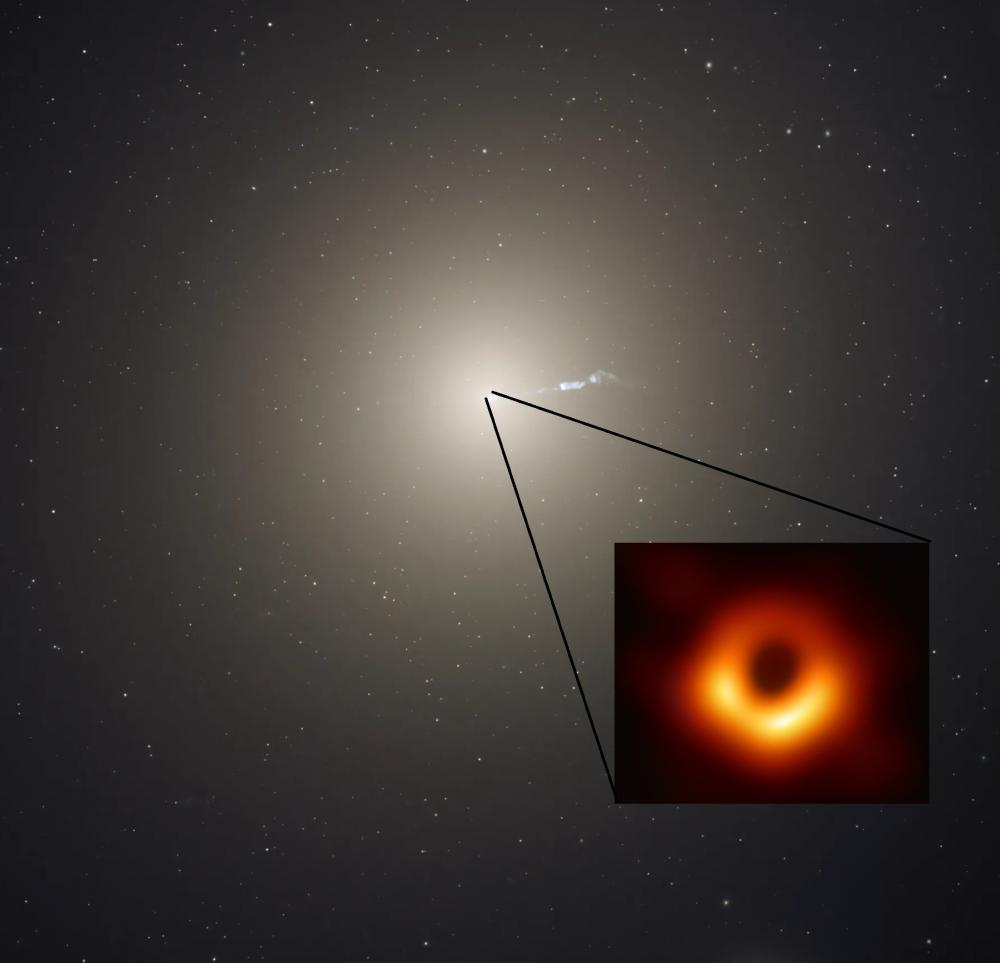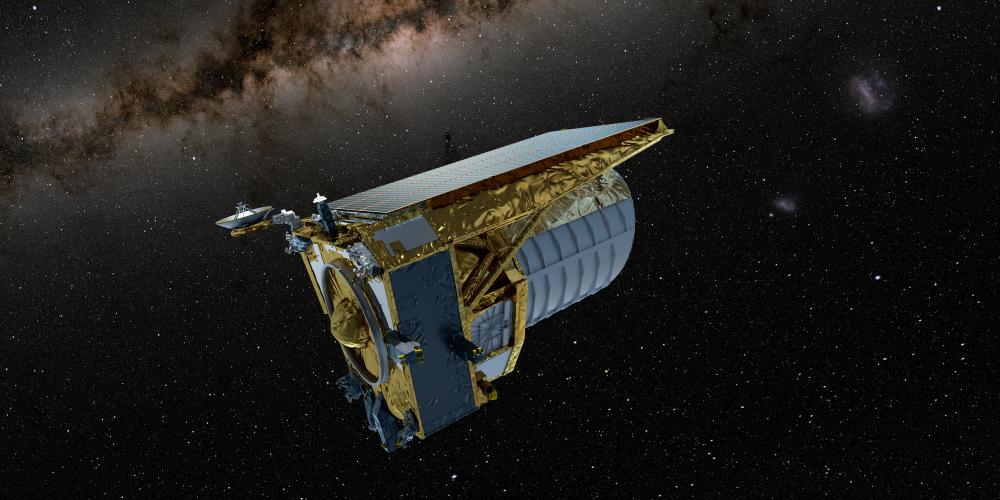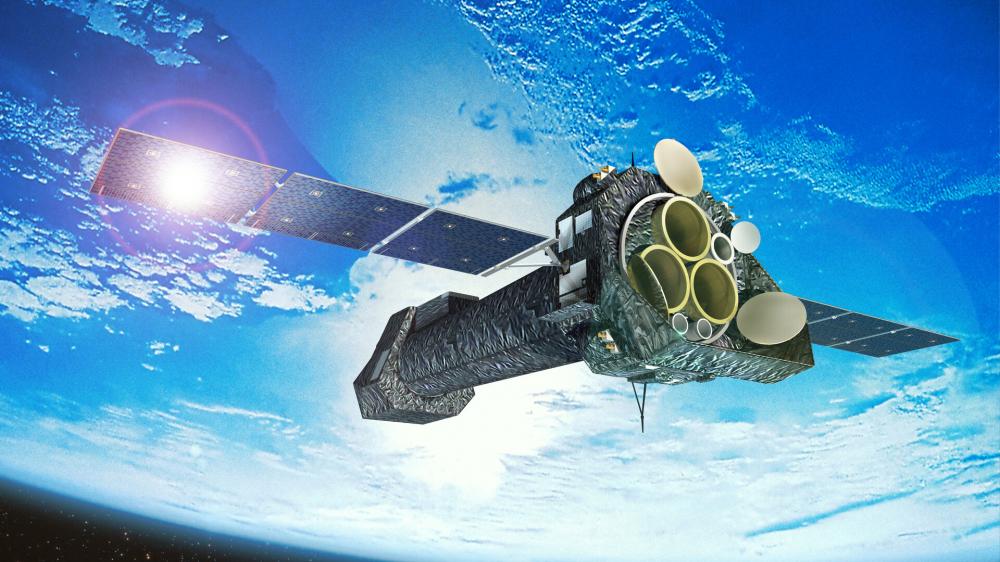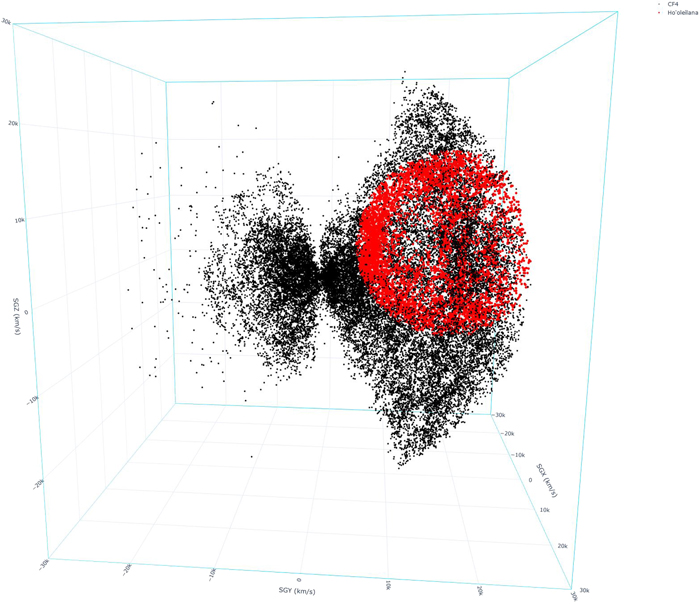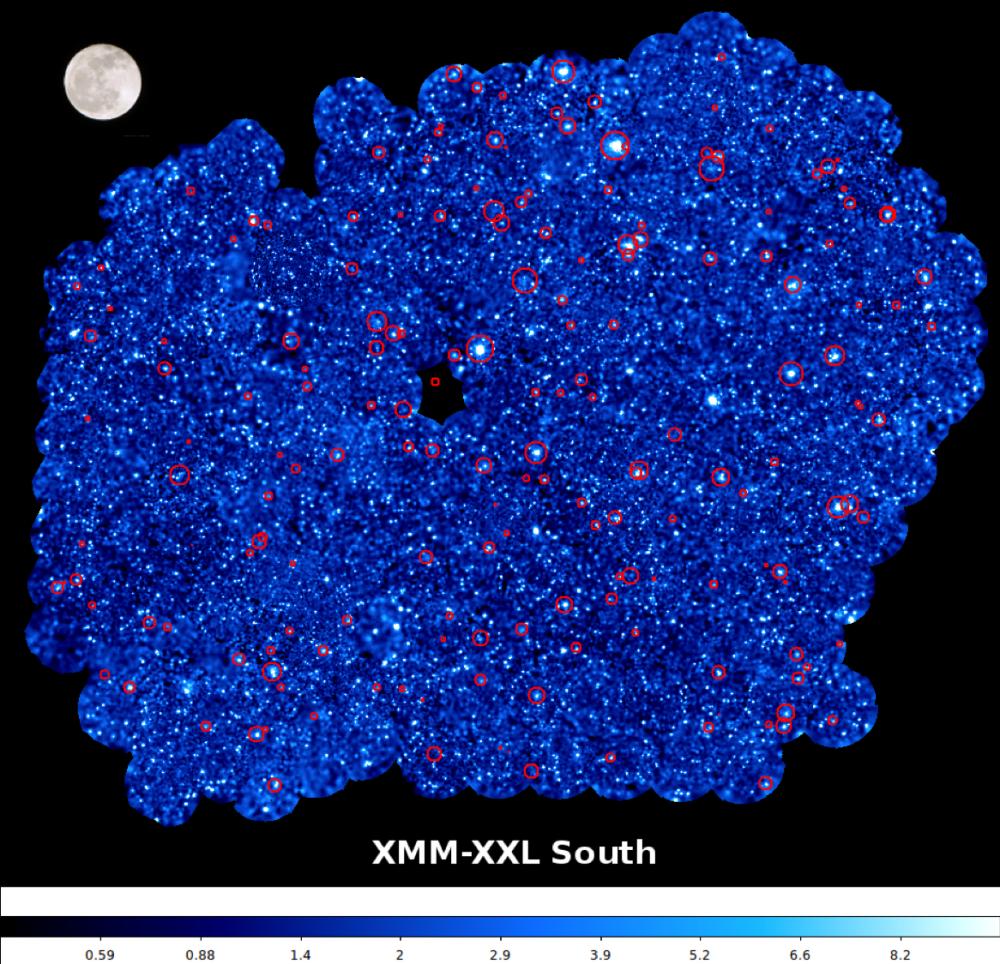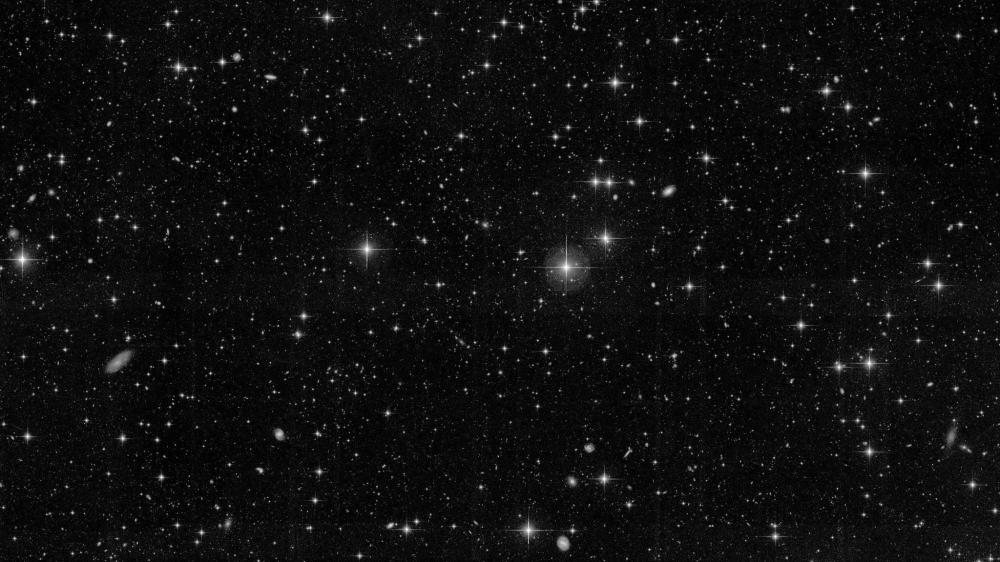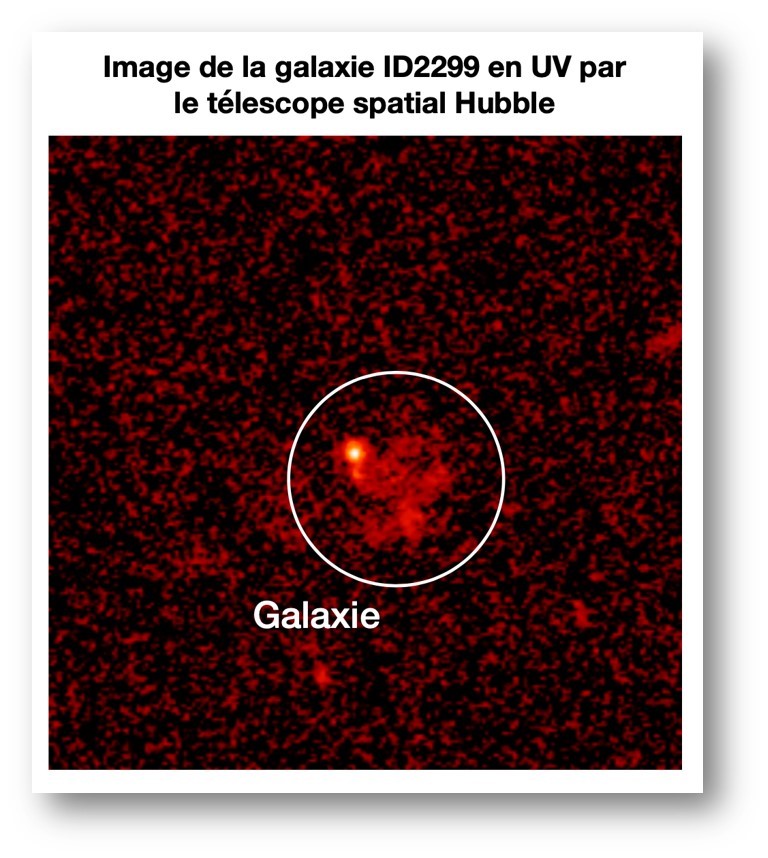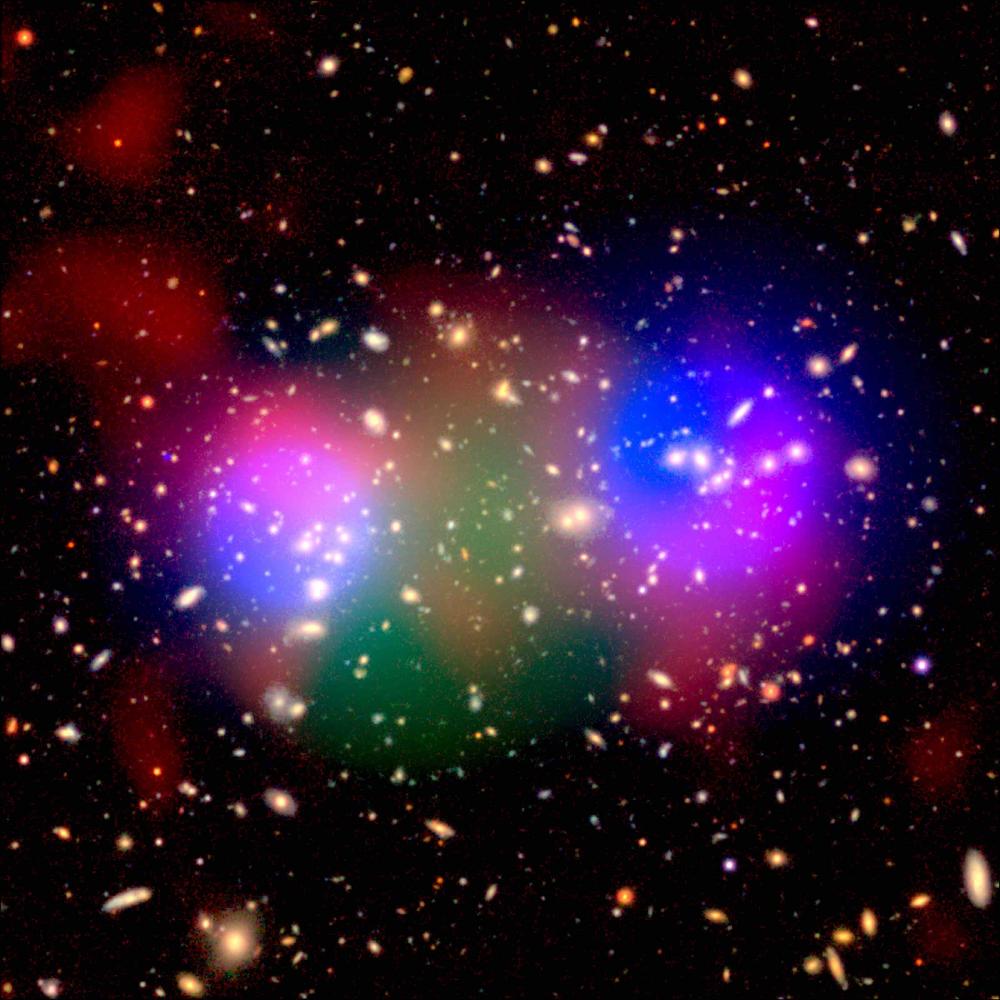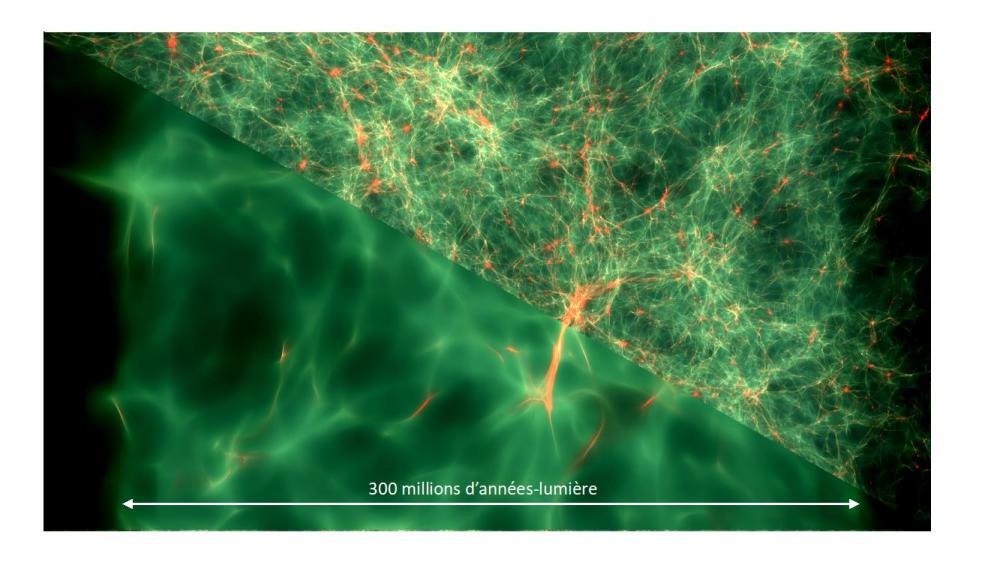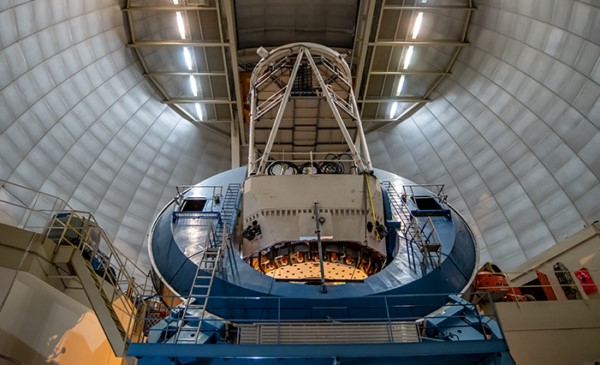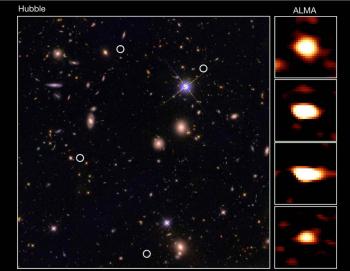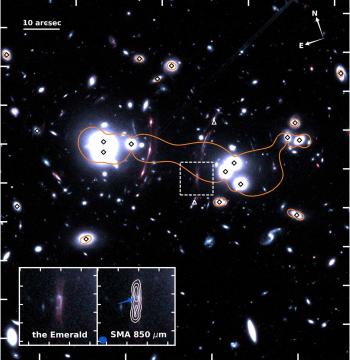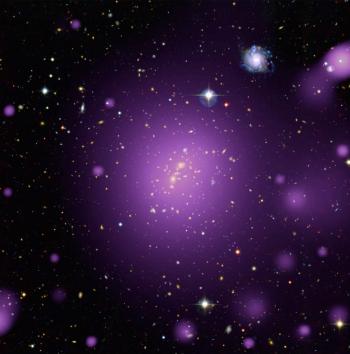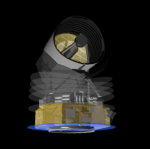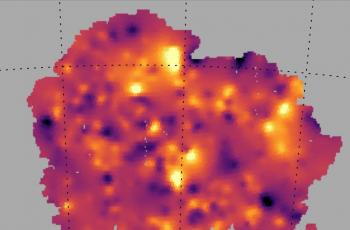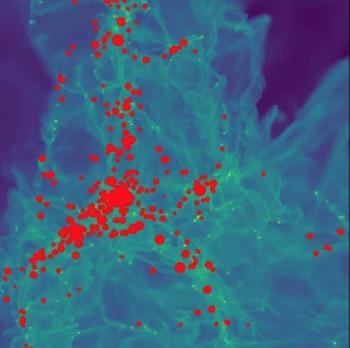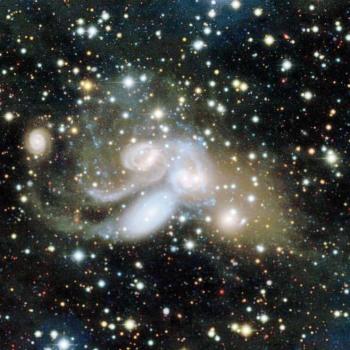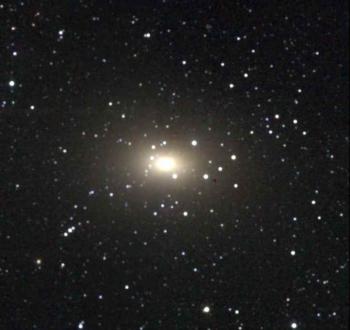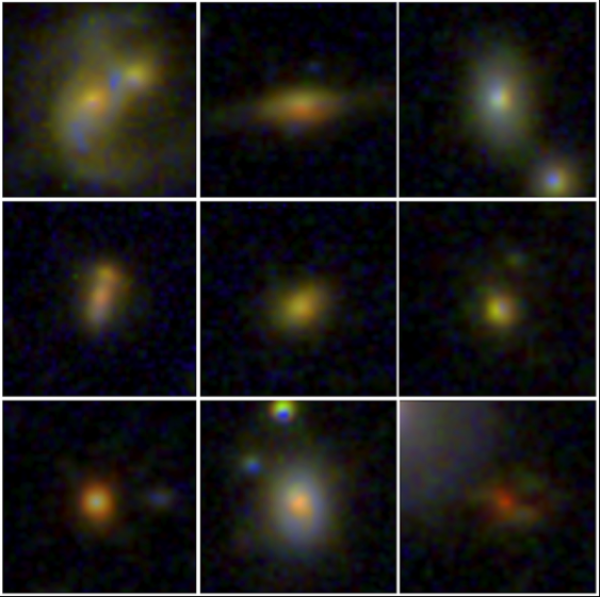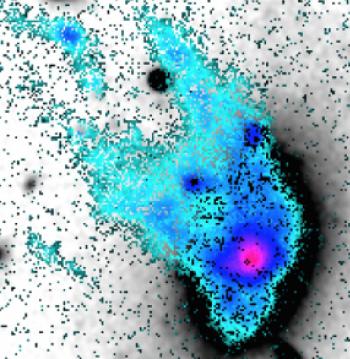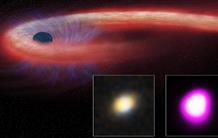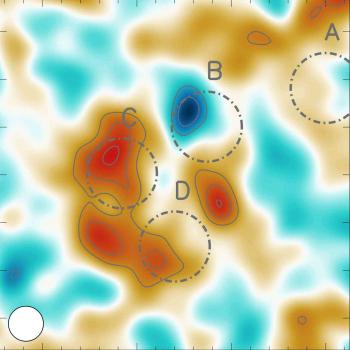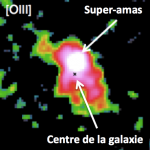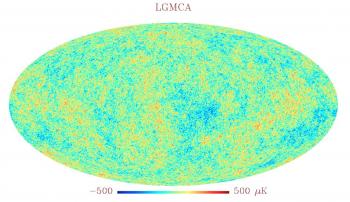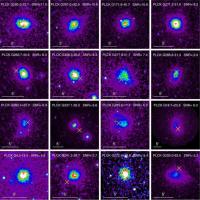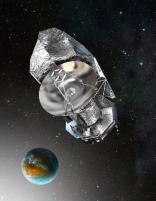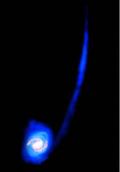Understanding the diverse stellar populations that make up galaxies is crucial to studying their formation over cosmic time. Nevertheless, some intractable stars continue to resist the modellers! Their complex nature and short lifetimes make stars in the asymptotic branch of thermally pulsating giants (TP-AGB) difficult to model, a subject of debate for decades. The James Webb Space Telescope is finally lifting the veil on their contribution to the spectrum of distant galaxies. These discoveries have implications for determining the age and stellar mass of galaxies, as well as for cosmic dust production and chemical enrichment.
This discovery has just been published in the prestigious journal Nature
It is well established that most galaxies harbor a supermassive black hole, long suspected of hindering the formation of new stars. However, no study had previously demonstrated a direct link between these black holes and the evolution of galaxies.
By analyzing dozens of galaxies, researchers, including those from the Department of Astrophysics at CEA – Paris-Saclay, discovered that the amount of hydrogen gas, essential for star formation, decreases in direct correlation with the mass of the central black hole, much more so than with the mass of the galaxy itself. This gas, primarily sourced from the accretion of matter from intergalactic space, appears to be blocked by black holes, preventing galaxies from replenishing external material. This phenomenon, termed "asphyxiation," suggests that black holes play a central role in the history of galaxies by limiting their growth.
This study was published in the prestigious journal Nature.
The Euclid collaboration today publishes five reference papers on the mission and ten scientific papers based on the first images unveiled to the public in November 2023, as well as the new images presented today by ESA.
This phase of preliminary observations conducted last fall provides a glimpse into the telescope's exceptional performance. The first scientific papers already reveal the discovery of newly formed rogue planets, the richness of the globular cluster population around nearby galaxies, the discovery of new low-surface-brightness dwarf galaxies in a neighboring galaxy cluster, the distribution of dark matter and intra-cluster light in galaxy clusters, and dozens of massive galaxies dating back to a time when the Universe was only 5% of its current age.
In parallel with these 15 articles, ESA today unveils five new images based on these observations, once again showcasing the sharpness of Euclid's images and its ability to observe all scales of the Universe from the optical to the near-infrared domain over a wide field of view, more than twice the surface area of the full Moon.
The CEA plays a major role in the entire mission within the Euclid collaboration, from design and implementation to its scientific exploitation over the next six years. The CEA is also heavily involved in this scientific validation program for the telescope set up by ESA. Jean-Charles Cuillandre, an astronomer at the CEA-Irfu Department of Astrophysics, analyzed these first scientific data transmitted by Euclid to create color images and enable their scientific exploitation. He is a co-author of the 10 scientific papers detailing the initial discoveries, including 2 as the first author, one on the Perseus galaxy cluster and the other on image processing.
XMM-Newton's energetic universe joins forces with the Euclid satellite's vision of the sky. A thousand hours of X-ray observations, over a region 40 times the size of the moon, will complement multi-wavelength studies of the cosmic evolution of galaxy clusters. A decisive association to constrain cosmological scenarios and reveal the nature of dark energy.
The question of our place in the Universe - "where are we in the Universe?" - is a fascinating one, and the source of one of the oldest sciences: Cosmography, the mapping of the Cosmos. Using a method based on the study of the velocity fields of galaxies measured by different telescopes, cosmographers - a team of researchers from the CEA, the University of Hawaii and the University of Queensland - reconstruct the cosmic web of our nearby Universe and reveal its architecture, revealing large structures of superclusters of galaxies, but also large voids, shaped by gravitation [1].
Daniel Pomarède, from Irfu, has been in charge of mapping Cosmicflows catalogues and displaying them in 3D and interactively since 2010. Between 2014 and today, their catalogue has grown from 8,000 to 56,000 galaxies, and the map is expanding with the inclusion of a catalogue of galaxies measured by the SDSS collaboration [2].
With their latest Cosmicflows-4 catalogue, they have just discovered an immense bubble of galaxies, a new fossil from the beginnings of our Universe, dating from the same period as the cosmic microwave background radiation. This is the first time that a remnant of a wave, witness to the primordial universe, has been measured individually in the distribution of galaxies.
These results have just been published in The Astrophysical Journal.
“Ho’oleilana: An Individual Baryon Acoustic Oscillation?” by R. Brent Tully, Cullan Howlett, and Daniel Pomarède, The Astrophysical Journal, Volume 954, Number 2 https://doi.org/10.3847/1538-4357/aceaf3
For the first time since the XMM launch (1999), a cosmological analysis constraining the density of matter in the universe, from a catalog of 178 galaxy clusters detected by XMM, has been possible and in an autonomous way, i.e. with its own distance measurements and without calling upon additional information from numerical simulations or other cluster samples. This analysis was conducted in the framework of the XXL consortium, mainly by Christian Garrel during his thesis at the Astrophysics Department (DAP) of CEA Paris-Saclay (see the article on arXiv).. The results confirm the standard cosmological model in a completely independent way, with an accuracy rivalling with other probes covering much larger portions of the sky. The existing "cosmological" tension between the cosmological analyses of the clusters and the CMB PLANCK is thus lifted; there is no longer any need to use massive neutrinos.
This cosmological analysis from clusters has been possible thanks to the new method ASpiX, developed at DAP allowing to model properly the distant clusters. In the distant Universe, we only detect massive clusters, thus blue, which appear red because of the expansion of the Universe. Mathematically, the software analyses all possible combinations of the effect of cosmology on the properties of clusters.
The cosmological analysis exploiting all the observations of the XXL program is in progress and will include about 300 clusters. The novelty is that it will combine the ASpiX method with artificial intelligence techniques that allow identifying very quickly the cosmological model that best reflects the observed properties of the cluster population.
Scientists from the CosmoStat laboratory at CEA have produced within the international science collaboration UNIONS (Ultraviolet Near Infrared Optical Northern Survey) a reference catalogue of 100 million gravitationally lensed distant galaxies, one of the largest datasets ever created. This new collection is based on thousands of deep images of the northern sky captured by MegaCam, a large digital camera built at CEA, mounted on the Canada-France-Hawaii Telescope (CFHT). Three new publications present dark-matter mass maps of the cosmic web, showing how the high-density regions in these maps help measure the still poorly known properties of dark matter. In the near future these observations will provide essential support to the European space telescope Euclid. This ESA satellite mission will map the cosmic web over the entire accessible sky at an unprecedented resolution to measure the properties of the mysterious dark energy.
Nearly 200 researchers were involved in collecting, processing and assembling images of half the sky to prepare for the start of observations by DESI, the Dark Energy Spectroscopic Instrument, which aims to solve the mystery of dark energy.
In order for DESI to begin its 5-year mission (2021-2026) to produce the largest 3D sky map ever made, researchers first needed a gigantic 2D map of the Universe. Based on 200,000 images from 1405 nights of observations on three telescopes and several years of satellite data, this 2D map is the largest ever produced, based on the area of sky covered, the depth of the imagery and the more than one billion images of galaxies it contains.
he "cosmic noon", when the universe was 4 to 5 billion years old, marked a very active period of star formation for most galaxies. Paradoxically, about a third of the most massive galaxies at that time were dead and no longer forming stars. To date, the shut down of star formation in galaxies is often attributed to gas outflows caused by the feedback of supermassive black holes, but their impact on the galaxies of the young Universe has not yet been definitively established.
Thanks to the ALMA interferometer, a team of astrophysicists in which the Astrophysics Department / AIM Laboratory of CEA Paris-Saclay is strongly involved, has detected an exceptional gas ejection in a massive galaxy at cosmic noon, called ID2299. According to their analyses the scenario of this announced death cannot come from black holes, but from the fusion of two galaxies which is at the origin of the galaxy. What if with this new scenario, we revisit the autopsy reports of dead galaxies... The quantitative observations of this study raise questions. The results have just been published in the journal Nature Astronomy: https://www.nature.com/articles/s41550-020-01268-x .
Three major observatories (Subaru, GBT and XMM-Newton) have joined their forces to observe the collision of a pair of galaxy clusters, HSC J023336-053022 (XLSSC 105), located four billion light years away. The spectacular image resulting from the data taken by the Subaru telescope in the visible, the Green Bank Telescope in radio and finally the X-ray satellite XMM-Newton (a space facility intensively used by the Astrophysical Department / AIM Laboratory of CEA Paris-Saclay in particular with its XMM-XXL program), shows that the violence of the shock heats the gas located between the clusters to more than 400 million degrees. It also allows indirect mapping of the dark matter present in the system. This was work was published in the September 2020 issue of the MNRAS journal.
See : the ESA press release
A team from IRFU's Department of Particle Physics (DPhP) has just conducted the most accurate study to date of the mass of cosmic neutrinos, including both standard model neutrinos and sterile neutrinos contributing to dark matter.
The researchers used the spectra of nearly 200,000 distant quasars measured by the Sloan Digital Sky Survey (SDSS) eBOSS project to map the distribution of hydrogen at very remote times in the history of our universe, ten to twelve billion years ago.
Neutrinos, propagating at relativistic speeds for billions of years, prevent gravity from acting on small scales and smooth the structures (clusters of galaxies, filaments, ...) revealed by the spectra of quasars. Thanks to the accuracy of the measurements, researchers have been able to narrow the possible range for the mass of cosmic neutrinos, to the point of being able to have their word on how the different masses of the three neutrinos of the Standard Model are ordered.
‘First light’ for the Dark Energy Spectroscopic Instrument (DESI): as the installation phase nears completion, this new instrument is due to undergo final tests before starting to create a giant map of the sky in early 2020, a mission that is scheduled to run for five years. CEA, the French National Centre for Scientific Research (CNRS), Aix-Marseille University and French company Winlight System have played a significant role in the project to develop this international instrument which aims to scan the sky in an attempt to understand the effects of dark energy.
A study conducted by astrophysicists of the Department of Astrophysics-AIM Laboratory of CEA-Irfu has revealed a large number of galaxies as massive as the Milky Way in the distant universe, thanks to the large interferometer ALMA (Atacama Large Millimeter/submillimeter Array) in Chile. These galaxies have hitherto remained invisible due to the attenuation of their brightness by interstellar dust. They are 10 to 100 times more numerous than all those detected so far, at distances where the universe was only two billion years old. This great abundance of massive galaxies in the young universe is in contradiction with current theoretical models of galaxy formation and represents a new challenge for our understanding of the early ages of the universe. These results are published in the journal Nature on August 7, 2019.
An international team, led by researchers from the Department of Astrophysics/AIM Laboratory of CEA-Irfu has just highlighted a new population of very remote galaxies, which had so far escaped the deepest observations of the Universe. During the summer of 2016, at more than 5000 meters of altitude on the Chilean highlands, the antennas of the large interferometer ALMA (Atacama Large Millimeter/submillimeter Array) scrutinized for more than 20 hours one of the best studied regions of the sky. These observations revealed galaxies still unknown, very massive but opaque, emitting only a very small amont of visible light due to a large quantity of dust. These "dark" galaxies, very far away, which could be the progenitors of the most massive galaxies in the universe, reveal that the importance of star formation, during the first billion years of cosmic history, could have been largely underestimated so far. These results have just been published in the journal Astronomy & Astrophysics.
Neutrinos from the Big Bang have been traveling the Universe for more than 13 billion years. They are almost undetectable but their footprint on the formation of large structures in the Universe, such as galaxies, can be detected. For the first time, this trace of the "diffuse neutrino background" from the Big Bang on the "baryonic acoustic oscillations" (BAO) has been deduced from the survey of 1.2 million galaxies of the "Sloan Digital Sky Survey" (SDSS). These data correspond to 5 years of observations from the Baryon Oscillation Spectroscopic Survey (BOSS) experiment, a ground-based telescope installed in New Mexico. The result, published in the journal Nature Physics, shows how the BAO phase can constrain the number of neutrino species in the Standard Model of Particle Physics.
The DPhP group has been involved in this project for more than 10 years and is currently working on its extension, the eBOSS project. In the very near future, the DESI project will be able to study even more precisely this cosmic neutrino background produced by the Big Bang.
Using NOEMA and the IRAM 30-m telescope, an international team of astronomers from different laboratories, including the Institut d'Astrophysique Spatiale (IAS-Université Paris-Sud/CNRS), the Laboratoire d’astrophysique de Marseille (Aix-Marseille Université/CNRS) and the Astrophysics Department of CEA-IRfu, just witnessed how the sites of the most intense star formation in the early Universe communicate with their surroundings through rapid gas exchange. Their findings offer unprecedented insights into the most rapid evolutionary phase of massive galaxies, about 11 billion years ago. The results are published in two diferent papers in Astronomy & Astrophysics on 2018 November, 30.
Using the ESA's XMM-Newton observatory, an international team, led by Marguerite Pierre of the Astrophysics Department of CEA-Irfu, has revealed the latest results of the XXL survey, the largest observation program X-ray produced to date by the XMM satellite. The second batch of data just published in a special issue of the journal Astronomy & Astrophysics, includes information on 365 galaxy clusters and 26,000 active galactic nuclei (AGN). By deep examination of two major regions of the sky, the XXL sounding is the first X-ray study to detect enough clusters of galaxies and AGN to trace the large-scale structure of the Universe and its evolution. in time with unprecedented details.
Read more in : Dessiner l'univers: les rayons X apportent une nouvelle lumière (in French)
The SPICA infrared space telescope has been shortlisted by the European Space Agency (ESA) to participate in the final competition which will see in September 2021 the choice of the next mission of medium size ESA (M5 mission). SPICA is a large infrared telescope (diameter 2.5 m) fully cooled to a temperature of only a few degrees above absolute zero. This concept was proposed to ESA as part of the competition for the M5 mission of the "Cosmic Vision" program (25 proposals submitted) by a consortium of European research laboratories led by Holland in close collaboration with the space agency Japan (JAXA), and in which the CEA (Département d'Astrophysique of CEA-Irfu), the CNRS and their associated universities participate in France with the support of CNES.
See the French version for more : La mission SPICA en compétition pour l'ESA
A team led by University College London (UCL), in collaboration with the Astrophysics Department of CEA-Irfu, has significantly improved the analysis of dark matter maps in the Universe with new methods of data analysis. The maps produced by this analysis demonstrate the power of these new innovative methods for analyzing future large data sets such as those expected from the upcoming EUCLID cosmological mission. These results are published in the MNRAS journal.
The mass distribution of the different stars formed from a collapsing gas cloud has just been successfully reproduced by two researchers from the Astrophysics Department/AIM Laboratory of CEA-Irfu. The collapse of a gas cloud of 1000 solar mass has been reconstructed thanks to numerical simulations, varying the density and the influence of turbulence. The results of these simulations show the emergence of a characteristic mass that corresponds well to that observed and this largely independently of the initial conditions and directly related to the behavior of the gas. This leads to a very good reproduction of the different masses of stars observed. So far, the mass distribution of stars has remained largely unexplained. These results are published in two articles of the Astronomy & Astrophysics journal.
The MegaCam camera developed at CEA-Irfu has revealed previously unsuspected structures within the famous Stephan Quintet, a spectacular combination of five galaxies. The discovery of a very large red halo, consisting of old stars, centered on one of the elliptical galaxies, NGC 7317, shows that the group of galaxies is still in very strong interaction, an aspect totally ignored in previous studies. This interaction shows that Stephan's Quintet is still the scene of generalized galactic cannibalism, in contradiction with the current theoretical predictions, which will therefore have to be revised. These results, from a team from the Strasbourg Astronomical Observatory, the CEA Astrophysics Department and the Lund Observatory (Sweden) are published in the Monthly Notices of the Royal Astronomical Society issue of January 2018.
By succeeding for the first time to analyze the light of nearly 1000 very distant elliptical galaxies, more than 10 billions light-years away, a team of researchers including three astrophysicists from the Astrophysics Department of CEA-Irfu has just revealed that these galaxies of the beginning of the universe contain a lot of gas but do not form stars. A real enigma that challenges our understanding of the evolution of these giant galaxies. These results are published in the journal Nature Astronomy of January 16, 2018.
Using images obtained with the Hubble Space Telescope, an international team of researchers led by Yu-Yen Chang from the Service d’Astrophysique-Laboratoire AIM at CEA–IRFU showed that some galaxies hosting an active nucleus are much more compact than those without nuclear activity. This discovery sheds new light on the physical processes driving the evolution of super-massive black holes at the center of distant galaxies. It suggests that the huge amount of gas needed for their growth could be funneled to the central region following the violent gravitational instabilities that occur within the galaxy gaseous disk. These instabilities may trigger a phase a dynamical contraction, hence explaining the ultra-compact morphology of the galaxies studied here. These results are published in the Monthly Notices of the Royal Astronomical Society.
An international team including a researcher from the AIM Laboratory-Astrophysics Department of CEA-Irfu has just discovered an elliptical galaxy of completely unexpected shape within the galaxy cluster Abell 2670. Deep observations made by the new MUSE multi-spectrograph recently put into operation at the European Observatory VLT in Chile revealed a highly deformed elliptical galaxy, showing in particular long gas tails and star formation regions normally absent in this type of galaxy. Astronomers now assume that this galaxy has undergone a recent fusion with another gas-rich galaxy. Much of this gas was then driven to the center of the elliptical galaxy during the collision. These results are published in the Astrophysical Journal Letters of May 2017
At the center of a small galaxy located about 1.8 billion light-years from Earth, a giant black hole swallowed a star for about a decade, which is exceptionally longer than any observed episode of this kind. This discovery was made by an international collaboration involving an astrophysicist from IRFU, thanks to a trio of orbiting X-ray telescopes.
A team of researchers led by Rémi Adam (Laboratoire Lagrange - OCA, UCA, LPSC Grenoble, CNES), Iacopo Bartalucci and Gabriel Pratt (Astrophysics Department- AIM Laboratory at CEA-Irfu) obtained for the first time an image of the gas velocity in colliding clusters of galaxies with NIKA [1], a new generation millimeter camera, at the focus of the 30 m diameter IRAM telescope of Pico Veleta (Spain). NIKA observations, which give accurate mapping of hot gas velocity in clusters, provide a new way to study the collision of clusters of galaxies, responsible for the most energetic events in the Universe after the Big Bang. This work is being published in the journal Astronomy & Astrophysics..
As part of an observing program carried out with the Hubble Space Telescope, a group of researchers from the “Service d’Astrophysique-Laboratoire AIM” of CEA-IRFU led by Anita Zanella discovered the birth cry of a massive star-forming clump in the disk of a very distant galaxy. This giant clump is less than 10 million years old, and it is the very first time that such a young star-forming region is observed in the distant Universe. This discovery sheds new light on how stars were born within distant galaxies. The physical properties of this object reveal that newly-born clumps in such galaxies survive from stellar winds and supernovae feedback, and can thus live for a few hundred million years unlike the predictions from several theoretical models. Their long lifetime could enable their migration toward the inner regions of the galaxy, hence contributing to the total mass of the galactic bulge and the growth of the central black hole. These results are published in the “Nature” journal from May 2015.
Using the latest data from the Planck and WMAP satellites, the laboratory CosmoStat (LCS) of CEA-IRFU just provides the most complete and accurate picture of the diffuse microwave background of the universe considered to be the primary light emitted at the beginning of the expansion. The new map of the diffuse background was built thanks to a new method of separating components called LGMCA particularly well suited to the separation of galactic foregrounds that blur the background image. Unlike previous results, the map restores the details of the diffuse background across the entire sky including the Galactic plane region of the sky where the estimate is particularly difficult. It is also more effective in reducing the defects introduced by the existence of hot gas in galaxy clusters. These results are in press in Astronomy & Astrophysics and were presented at the conference "Horizon of Statistics" on January 21, 2014 at the Institut Henri Poincare (Paris).
To retrace the history of the Universe, physicists need to make images of it at its different ages, going back tens of billions of years.
Scientists from the Sloan Digital Sky Survey (SDSS-III), including a group from Irfu and CNRS (IN2P3 and INSU), have produced the largest map of the distant Universe from the BOSS (Baryon Oscillations Spectroscopic Survey) survey. This three-dimensional map shows the position in space and time of intergalactic hydrogen gas clouds. It was obtained using light from the brightest objects in the cosmos, quasars, which illuminate these clouds that can then be imaged. More than 14,000 quasars were used to make this first hydrogen map of the Universe, whose 3rd dimension allows us to go back in time. At the end of 2014, a new map will be established using a number of quasars ten times higher. It will then offer a new view of the Universe as it existed 11 billion years ago and will make it possible to study how the expansion of the Universe has evolved throughout its history.
An international team, including scientists from the Astrophysics Department-AIM and the Particle Physics Department of CEA-Irfu, has just used the Planck satellite to discover galaxy clusters with characteristics that were previously unknown. These clusters, which contain up to a thousand galaxies, are the largest structures in the Universe. Many of them are located very far away from us, and we still know relatively little about them. Astrophysicists were able to detect the new clusters thanks to the imprint left in the background radiation of the universe by the hot gas from the clusters. Of the 189 clusters detected by Planck at distances from 1 to 5 billion light-years, 20 were previously unknown. Thanks to a joint program with the XMMNewton x-ray satellite, some of these new clusters could be observed, revealing weaker luminosity and a highly perturbed gas distribution. These must therefore be clusters with different characteristics.
These results were presented at a scientific colloquium on results from the Planck satellite, held from 10th to 14th January 2011 in Paris. They were published in a special issue of Astronomy & Astrophysics.
For a more detailed account, see also the French version.
A major international collaboration [1], involving researchers from the CEA-IRFU Astrophysics Department, CEA-IRAMIS and CEA-DAM, has succeeded in measuring for the first time the effects of light absorption by nickel in high temperature plasmas similar to those found around Cepheid-type variable stars. These stars are important indicators of distance in the Universe. They exhibit a periodic pulsing behavior caused by sudden increases in the absorption of light by the hot gas surrounding the star. These variations result from interactions between partially ionized elements including helium, oxygen, iron and nickel. Until now, these absorptions could only be evaluated using complex models of atomic physics and plasmas. Using a pulsed laser, the researchers have succeeded in recreating a nickel plasma in the laboratory at temperatures of between 116 000 and 440 000 degrees and with densities of around a few milligrams per cubic centimeter, similar in magnitude to the ionic distributions found in stellar envelopes. A direct measurement of the opacity of nickel is an essential step in the verification of current models of star structures.
‘High-resolution’ numerical simulations carried out by scientists at the Astrophysics Department of the CEA-Irfu/AIM have just revealed that the most famous galactic collision ever, the Antennae collision, produces far more stars than observations suggested. When two galaxies meet, the resulting gas compression causes the ignition of new stars. Until now, it seemed that these new stars appeared only in high-density regions, mainly near the core of the collision. A computer re-creation of the collision, with a sufficiently high resolution to pick out the smallest gas clouds for the first time, shows that the starburst is in fact distributed far more uniformly inside the large number of star superclusters scattered across the disks of the galaxies. This important result helps scientists to understand why, in certain collisions, around 100 to 1000 stars per year can appear at the same time. This work was published in Astrophysical Journal Letters.
An international team led by astrophysicists from the Lyon Observatory (CRAL, CNRS/INSU, Université Lyon 1) and the AIM laboratory (CEA-Irfu, CNRS, Université Paris 7) has just shed some light on the origins of the giant gas ring in Leo. The astrophysicists were able to detect an optical counterpart to this cloud, which corresponds to stars in formation, using the Canada-France-Hawaii telescope (INSU-CNRS, CNRC, U. Hawaii). The scientists then carried out numerical simulations on the supercomputers at the CEA and suggested a scenario for the formation of this ring. This involved a violent collision between two galaxies. The researchers were able to identify the galaxies involved in the collision and estimate the date of impact. This discovery supports the assertion that the gas in the ring is not primordial, but of galactic origin. This work was published in Astrophysical Journal Letters.
One year on from the launch of the Herschel European satellite, the European Space Agency (ESA) is carrying out an initial scientific assessment of the mission, starting with the first symposium of Herschel scientific results, held from 4th to 7th May on the ESTEC site in Noordwijk (Netherlands).
The scientific community has been analyzing the initial data received since Herschel was declared 'science-ready' in September 2009. More than 400 scientists gathered at ESTEC to present their initial results, which have lived up to everyone's expectations. These results are due for publication in a special issue of Astronomy & Astrophysics in the autumn of 2010, and are mentioned in a CNRS-CEA press release.
The French community is deeply involved in the Herschel project, accounting for 25% of the participants, including several teams from the Astrophysics Department of the CEA-IRFU-AIM Laboratory.
Following its launch on 14 May 2009, the Planck satellite [1] has been continually observing the celestial vault and has mapped the entire sky since 13 August to obtain the first very high resolution image of the dawn of the universe. The Planck satellite has just finished its first sky coverage. The preliminary images reveal undreamed of details of emissions of gas and dust in our own galaxy. Scientists from CEA-IRFU, as part of a broad international collaboration, are currently working on the extraction and exploitation of the catalogues of objects detected by Planck. These preliminary catalogues are essential to understanding and subtracting stray foreground emissions from the background light of the universe, a fossil trace of its earliest epochs. It is also improving understanding of the formation of the largest structures in the universe, clusters of galaxies. The first catalogue will be published in January 2011. In contrast, the definitive scientific publications on the first light of the universe are not expected until the end of 2012.
What is a galaxy ? Stars, gas, some dust and surrounding them an invisible dark matter halo. The discovery a few years ago of a so-called « dark galaxy » devoid of its most famous component - the stars - raised a lot of interest in the public and among astrophysicists puzzled by a specimen which had not been predicted by classical models. A team from the Service d'Astrophysique (SAp) and laboratory AIM (CNRS, CEA-Saclay, Université Paris Diderot has used numerical simulations to show that VirgoHI21, believed to be a massive dark galaxy, was in fact most probably collisional debris from a past encounter between two massive galaxies in the Virgo Cluster. The prototypical dark galaxy is no longer one ! These results will be published in the February 2008 issue of the Astrophysical Journal.

